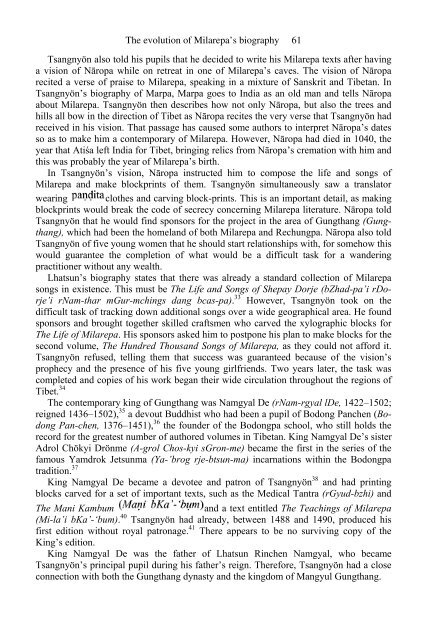The Biographies of Rechungpa: The Evolution of a Tibetan ...
The Biographies of Rechungpa: The Evolution of a Tibetan ...
The Biographies of Rechungpa: The Evolution of a Tibetan ...
Create successful ePaper yourself
Turn your PDF publications into a flip-book with our unique Google optimized e-Paper software.
<strong>The</strong> evolution <strong>of</strong> Milarepa’s biography 61<br />
Tsangnyön also told his pupils that he decided to write his Milarepa texts after having<br />
a vision <strong>of</strong> Nāropa while on retreat in one <strong>of</strong> Milarepa’s caves. <strong>The</strong> vision <strong>of</strong> Nāropa<br />
recited a verse <strong>of</strong> praise to Milarepa, speaking in a mixture <strong>of</strong> Sanskrit and <strong>Tibetan</strong>. In<br />
Tsangnyön’s biography <strong>of</strong> Marpa, Marpa goes to India as an old man and tells Nāropa<br />
about Milarepa. Tsangnyön then describes how not only Nāropa, but also the trees and<br />
hills all bow in the direction <strong>of</strong> Tibet as Nāropa recites the very verse that Tsangnyön had<br />
received in his vision. That passage has caused some authors to interpret Nāropa’s dates<br />
so as to make him a contemporary <strong>of</strong> Milarepa. However, Nāropa had died in 1040, the<br />
year that Atiśa left India for Tibet, bringing relics from Nāropa’s cremation with him and<br />
this was probably the year <strong>of</strong> Milarepa’s birth.<br />
In Tsangnyön’s vision, Nāropa instructed him to compose the life and songs <strong>of</strong><br />
Milarepa and make blockprints <strong>of</strong> them. Tsangnyön simultaneously saw a translator<br />
wearing clothes and carving block-prints. This is an important detail, as making<br />
blockprints would break the code <strong>of</strong> secrecy concerning Milarepa literature. Nāropa told<br />
Tsangnyön that he would find sponsors for the project in the area <strong>of</strong> Gungthang (Gungthang),<br />
which had been the homeland <strong>of</strong> both Milarepa and <strong>Rechungpa</strong>. Nāropa also told<br />
Tsangnyön <strong>of</strong> five young women that he should start relationships with, for somehow this<br />
would guarantee the completion <strong>of</strong> what would be a difficult task for a wandering<br />
practitioner without any wealth.<br />
Lhatsun’s biography states that there was already a standard collection <strong>of</strong> Milarepa<br />
songs in existence. This must be <strong>The</strong> Life and Songs <strong>of</strong> Shepay Dorje (bZhad-pa’i rDorje’i<br />
rNam-thar mGur-mchings dang bcas-pa). 33 However, Tsangnyön took on the<br />
difficult task <strong>of</strong> tracking down additional songs over a wide geographical area. He found<br />
sponsors and brought together skilled craftsmen who carved the xylographic blocks for<br />
<strong>The</strong> Life <strong>of</strong> Milarepa. His sponsors asked him to postpone his plan to make blocks for the<br />
second volume, <strong>The</strong> Hundred Thousand Songs <strong>of</strong> Milarepa, as they could not afford it.<br />
Tsangnyön refused, telling them that success was guaranteed because <strong>of</strong> the vision’s<br />
prophecy and the presence <strong>of</strong> his five young girlfriends. Two years later, the task was<br />
completed and copies <strong>of</strong> his work began their wide circulation throughout the regions <strong>of</strong><br />
Tibet. 34<br />
<strong>The</strong> contemporary king <strong>of</strong> Gungthang was Namgyal De (rNam-rgyal lDe, 1422–1502;<br />
reigned 1436–1502), 35 a devout Buddhist who had been a pupil <strong>of</strong> Bodong Panchen (Bodong<br />
Pan-chen, 1376–1451), 36 the founder <strong>of</strong> the Bodongpa school, who still holds the<br />
record for the greatest number <strong>of</strong> authored volumes in <strong>Tibetan</strong>. King Namgyal De’s sister<br />
Adrol Chökyi Drönme (A-grol Chos-kyi sGron-me) became the first in the series <strong>of</strong> the<br />
famous Yamdrok Jetsunma (Ya-’brog rje-btsun-ma) incarnations within the Bodongpa<br />
tradition. 37<br />
King Namgyal De became a devotee and patron <strong>of</strong> Tsangnyön 38 and had printing<br />
blocks carved for a set <strong>of</strong> important texts, such as the Medical Tantra (rGyud-bzhi) and<br />
<strong>The</strong> Mani Kambum and a text entitled <strong>The</strong> Teachings <strong>of</strong> Milarepa<br />
(Mi-la’i bKa’-‘bum). 40 Tsangnyön had already, between 1488 and 1490, produced his<br />
first edition without royal patronage. 41 <strong>The</strong>re appears to be no surviving copy <strong>of</strong> the<br />
King’s edition.<br />
King Namgyal De was the father <strong>of</strong> Lhatsun Rinchen Namgyal, who became<br />
Tsangnyön’s principal pupil during his father’s reign. <strong>The</strong>refore, Tsangnyön had a close<br />
connection with both the Gungthang dynasty and the kingdom <strong>of</strong> Mangyul Gungthang.











